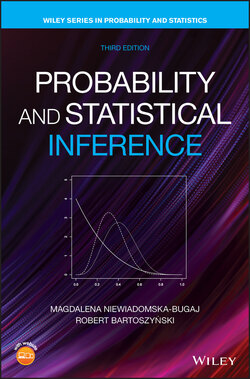Читать книгу Probability and Statistical Inference - Robert Bartoszynski - Страница 85
Example 3.9
ОглавлениеTo supplement their revenues, many states are sponsoring number games or lotteries. The details vary from state to state, but generally, a player who buys a lottery ticket chooses several numbers from a specified set of numbers. We will carry the calculations for the choice of 6 out of 50 numbers which is quite typical. After the sales of tickets close, six winning numbers are chosen at random from the set . All those (if any) who chose six winning numbers share the Big Prize; if there are no such winners, the Big Prize is added to the next week's Big Prize. Those who have five winning numbers share a smaller prize, and so on. Let be the probability that a player has exactly winning numbers. We will compute for and 3. The calculations would be the same if the winning numbers were chosen in advance, but remained secret to the players. We can now represent the situation in a familiar scheme of an urn with 6 winning numbers and 44 losing numbers, and the choice of 6 numbers from the urn (without replacement). This is the same problem as that of labeled fish. The total number of choices that can be made is , while is the number of choices with exactly winning numbers. Thus,
For , we have
Similarly and .
Thus, the chances of winning a share in the Big Prize are about 1 in 16 million. It would therefore appear that there should be, on average, one big winner in every 16 million tickets sold. The weekly numbers of tickets sold are well known, and it turns out that the weekly numbers of winners (of the Big Prize) vary much more than one would expect. For example, in weeks where the number of tickets sold is about 16 million, one could expect no winner, one winner, or two winners; three winners is unlikely. In reality, it is not at all uncommon to have five or more winning tickets in a week with 16 million tickets sold. These observations made some people suspicious about the honesty of the process of drawing the numbers, to the extent that there have been attempts to bring suit against the lottery (e.g., accusing the organizers of biasing the lottery balls with certain numbers so as to decrease their chance of being selected, thus favoring some other numbers).
Actually, the big variability of weekly numbers of winners is to be expected if one realizes that these numbers depend on two chance processes: the choice of winning numbers from the urn (which may be, and probably is, quite fair) and the choice of numbers by the players. This choice is definitely not uniform. It favors certain combinations, which seem more “random” to the naive persons than other choices. For instance, the combination appears less likely than (say) and 45. As a consequence some combinations are selected more often by the players than others. Each combination has the same chance of being the winning one, but some may have higher numbers of winners associated with them. This point can be illustrated by the following analogy: Imagine that each week a first name (Mary, Susan, George, etc.) is chosen at random from the set of all names used, and all persons in the state with the selected name share the prize. The chances of being chosen are the same for John as for Sebastian, as they depend on the process of sampling names of winners. But if the name Sebastian is chosen, each Sebastian will share the prize with many fewer other winners than if the name John were selected. Here the numbers of winners to share the prize depend on another process, namely that of parents selecting names for their children.
